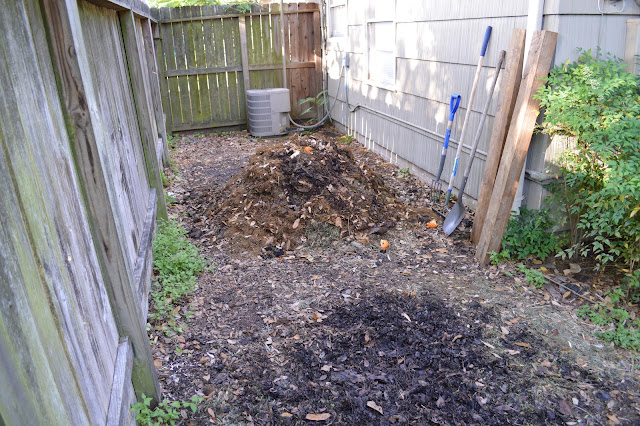My back yard nook is almost completely shaded, with small spots of light sneaking in now and then. My yard's turf grass, St. Augustine grass, does not grow here, but tufts of grass and other forbs, such as erect dayflower, manage to live here.
The nook is the first part of my back yard to get standing water. In heavier or longer rains, the entire space can be covered with water.
On August 23, 2013, in the process of creating the C Bed, I used the nook as a place to separate the grass I removed from the ground from the big clumps of dirt to which it was attached. I had a pile for the grass and another for the dug-up dirt and the garden soil I had brought from my previous house.
 |
| Click the photo to see it bigger! |
By August 25, 2013, I had moved all that soil into the C Bed.
A young Persian silk tree sapling had taken hold between the a/c compressor and the house. Its mother tree is on the other side of the fence, in the east yard.
The backyard nook was also a haven for erect dayflower in 2013.
After I dug up more grass to create the triangle bed, I made a new pile of grass in the nook on September 2, 2013.
On September 16, 2013, I switched the piles again, putting the jasmine vines in the open end of the space, and the grass in the closed end. To the grass, I might have added the nandina leaves and sticks after having cleared the plant from along the bedroom wall in the herb garden. I must have recently added coffee grounds to the pile because some Starbucks trash bags are lying by the side of the house.
On September 27, 2013, I tossed some cleavers and stray swamp lilies onto the jasmine vine pile.
On February 24, 2014, I had moved what was left of the piles to the back of the nook. I was getting prepared to start hot composting, but the jasmine vines were too tough to decompose quickly.
By March 9, 2014, I seem to have turned over the pile and added more coffee grounds and kitchen scraps, along with some shredded paper. The area behind this pile, where a pile had been a couple weeks before, was now scraped clear.
On March 13, 2014 I had two complete compost piles. The one in front is the farthest along. The two piles are a little connected, but the peak of the back pile is clearly visible.
On March 29, 2014, I had a compost pile that was at least 140 degrees in the middle. That was as high as the thermometer could go.
On May 8, I photographed a black soldier fly laying eggs in an orange peel that was on a compost pile.
From the series of photos I took, I could determine some of the ingredients I was using:
- watermelon scraps
- oak catkins
- grass clippings collected from the neighborhood
- coffee grounds
- rejected kale and collard leaves
- small dead twigs
- leaves, mostly oak leaves
- other assorted yard waste
On May 28, 2014, following a rain, the back yard nook had signs that water had pooled and flowed there. These small plant bits collected by the northeast corner of the bedroom.
This collection of plant detritus was on the house side of the compost pile that was there at the time.
On June 17, 2014, the two compost piles in the nook looked well formed, though the back pile was small. Two large bags of orange rinds from Whole Foods had been placed by the wall.
On October 19, 2014, all the other piles had been removed, and a new one was started, though it would not be able to decompose properly until the middle of next spring.
On February 1, 2015, I was getting a jump start on the new year.
On March 29, 2015, I had a full composed, with some exposed "green" on top and catkins all over. Underneath are signs of coffee grounds.
[more to come here...]
In 2016 and 2017, I generally used the nook as a place for wood to decay. If I could break an old branch with my hands or by smacking it into the ground, I put it in the walkways between my garden beds. If I couldn't break it, I tossed it into the nook.





















